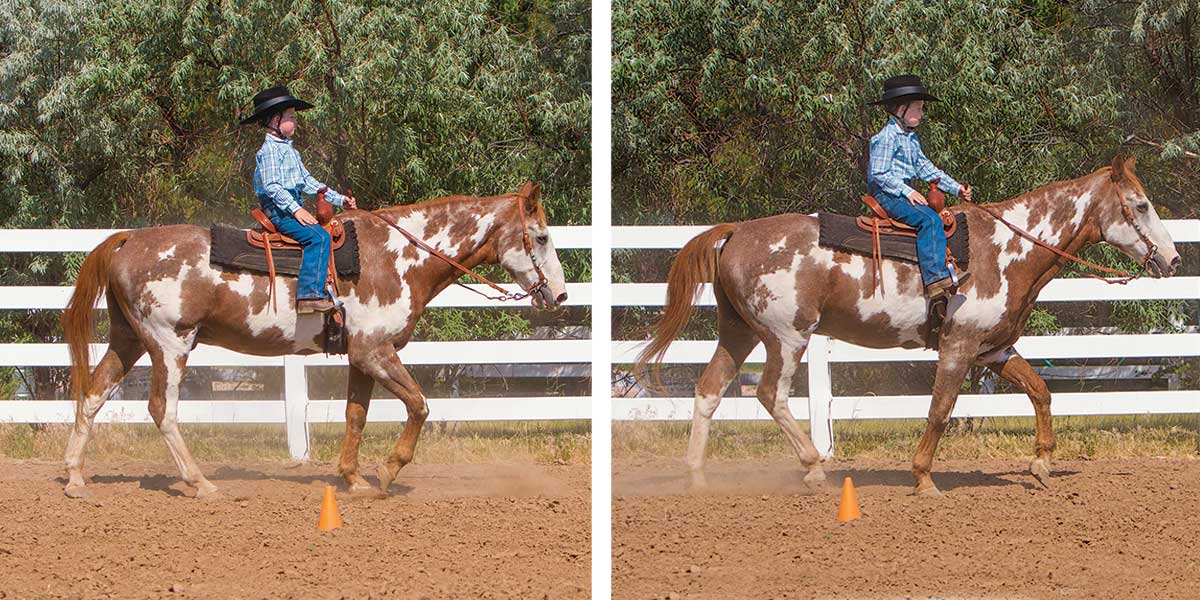Here’s how this exercise came to be. An older student of mine had been bucked off in a lope depart and was terrified of loping. Even the thought of it brought panic attacks. She spent her entire lessons worrying about the moment I might ask her to pick up a lope.
I knew I had to get her mind focused away from her fears, so I started shooting directives at her in short intervals.
“Now trot,” I’d say. Moments later: “Now turn across the arena.” Moments later: “Now stop and back up.” I kept at it until I saw a smile that indicated she was having fun. Eventually, I slipped in, “Now lope,” but only for a stride or two, then back to a walk.
And she did it without even thinking about the fact that she was loping. Goal achieved!


Why It Works
When you’re nervous about something, it’s almost impossible to stop thinking about it. Telling yourself to stop is useless. It’s like telling yourself not to think about an elephant: The only thing you can picture in your mind is huge and gray, with a trunk.
But when you’re actively involved in something physical that commands your attention, it’s hard to stay focused on anything else. If you’re riding around the arena for long stretches of time doing just one thing, your mind can wander back to what’s bothering you. But if you have to keep changing what you’re doing, you have to stay focused on the cues and movements needed to accomplish those
changes smoothly.
Since that first scared-to-lope student, I’ve used the same technique successfully on different riders with various issues. It never fails to help the students, plus it helps their horses learn to pay closer attention to them, as well. The horse focuses on his rider, and the rider focuses on riding rather than on her nerves.
How, With a Helper
If you take lessons, ask your trainer or instructor to direct this exercise for you. Explain the concept and ask him or her to instruct that you execute a change of gait, maneuver, or direction every 30 seconds or so, for a period of up to five minutes at a time. The instructions can be simple (walk, trot, turn, stop) or mixed with more demanding movements (extended trot, leg-yield, counter-bend, sidepass) as appropriate for your level of riding.
Then, when both you and your horse are fully focused, your regular lesson can resume. If you become nervous or unfocused at any other point during the lesson, repeat the exercise.
If you don’t have a trainer, ask a horse-savvy friend to be the “caller” for you. Have your friend bring a horse, and you can take turns calling changes for each other.
How, On Your Own
If you ride alone, simply designate one or two objects in or around your arena (this post, that tree) as markers, then change what you and your horse are doing every time you pass one of them. This is a little more demanding than having someone call changes to you, as it means you must keep track of the markers and decide what the change is to be. (The good news is you’ll truly have zero mental energy left to devote to any of your worries.)
You can also use a traffic cone or two to designate where changes should occur. Just be sure you don’t fall into a repeating pattern, which is less demanding mentally. The whole point is to make you think.
Finally, you can use a repeating interval timer (such as designed for interval training in workouts) to signal changes every 30 seconds. Simply set it, clip it to your belt, and off you go.
You’ll be fully focused on riding—and having a blast—in no time.
Cody Crow trains horses and coaches amateurs in reining, cow horse, and versatility from his home base in Berthoud, Colorado. He’s won a world championship and a reserve in ranch riding events at the Appaloosa and Quarter Horse world shows, respectively (facebook.com/cody.crow.50).






